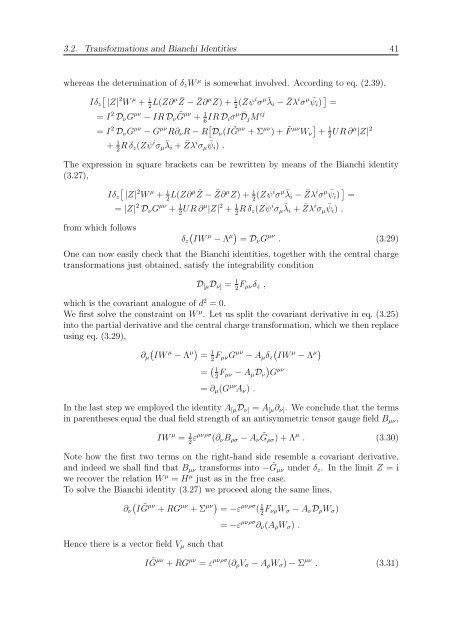N=2 Supersymmetric Gauge Theories with Nonpolynomial Interactions
N=2 Supersymmetric Gauge Theories with Nonpolynomial Interactions
N=2 Supersymmetric Gauge Theories with Nonpolynomial Interactions
Create successful ePaper yourself
Turn your PDF publications into a flip-book with our unique Google optimized e-Paper software.
3.2. Transformations and Bianchi Identities 41<br />
whereas the determination of δzW µ is somewhat involved. According to eq. (2.39),<br />
2 µ i<br />
Iδz |Z| W + 2L(Z∂µ Z¯ − Z∂ ¯ µ i Z) + 2 (Zψiσ µ¯ λi − ¯ Zλ i σ µ ψi) ¯ =<br />
= I 2 DνG µν − IR Dν ˜ G µν + 1<br />
6IR Diσ µ DjM ¯ ij<br />
= I 2 DνG µν − G µν R∂νR − R Dν(I ˜ G µν + Σ µν ) + ˜ F µν <br />
1<br />
Wν + 2UR ∂µ |Z| 2<br />
+ 1<br />
2R δz(Zψ i σµ ¯ λi + ¯ Zλ i σµ ¯ ψi) .<br />
The expression in square brackets can be rewritten by means of the Bianchi identity<br />
(3.27),<br />
2 µ i<br />
Iδz |Z| W + 2L(Z∂µ Z¯ − Z∂ ¯ µ i Z) + 2 (Zψiσ µ¯ λi − ¯ Zλ i σ µ ψi) ¯ =<br />
= |Z| 2 DνG µν + 1<br />
2UR ∂µ |Z| 2 + 1<br />
2R δz(Zψ i σµ ¯ λi + ¯ Zλ i σµ ¯ ψi) ,<br />
from which follows<br />
µ µ<br />
δz IW − Λ = DνG µν . (3.29)<br />
One can now easily check that the Bianchi identities, together <strong>with</strong> the central charge<br />
transformations just obtained, satisfy the integrability condition<br />
D[µDν] = 1<br />
2 Fµνδz ,<br />
which is the covariant analogue of d 2 = 0.<br />
We first solve the constraint on W µ . Let us split the covariant derivative in eq. (3.25)<br />
into the partial derivative and the central charge transformation, which we then replace<br />
using eq. (3.29),<br />
µ µ<br />
∂µ IW − Λ = 1<br />
2 FµνG µν − Aµδz<br />
= 1<br />
2 Fµν − AµDν<br />
= ∂µ(G µν Aν) .<br />
IW µ − Λ µ <br />
G µν<br />
In the last step we employed the identity A[µDν] = A[µ∂ν]. We conclude that the terms<br />
in parentheses equal the dual field strength of an antisymmetric tensor gauge field Bµν,<br />
IW µ = 1<br />
2 εµνρσ (∂νBρσ − Aν ˜ Gρσ) + Λ µ . (3.30)<br />
Note how the first two terms on the right-hand side resemble a covariant derivative,<br />
and indeed we shall find that Bµν transforms into − ˜ Gµν under δz. In the limit Z = i<br />
we recover the relation W µ = H µ just as in the free case.<br />
To solve the Bianchi identity (3.27) we proceed along the same lines,<br />
<br />
∂ν IG ˜µν µν µν<br />
+ RG + Σ = −ε µνρσ ( 1<br />
2FνρWσ − AνDρWσ)<br />
Hence there is a vector field Vµ such that<br />
= −ε µνρσ ∂ν(AρWσ) .<br />
I ˜ G µν + RG µν = ε µνρσ (∂ρVσ − AρWσ) − Σ µν . (3.31)

















